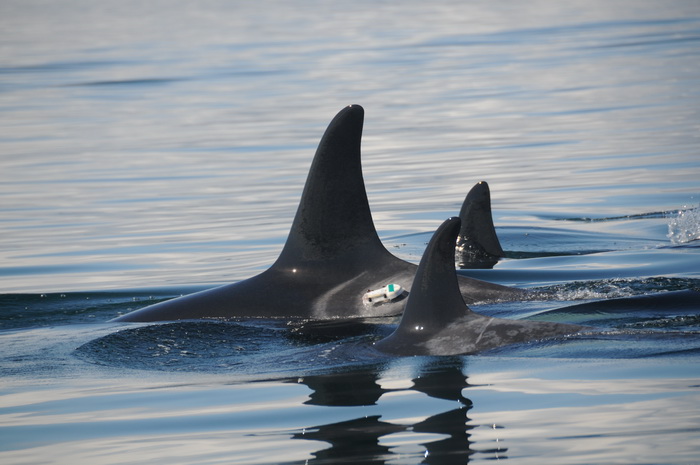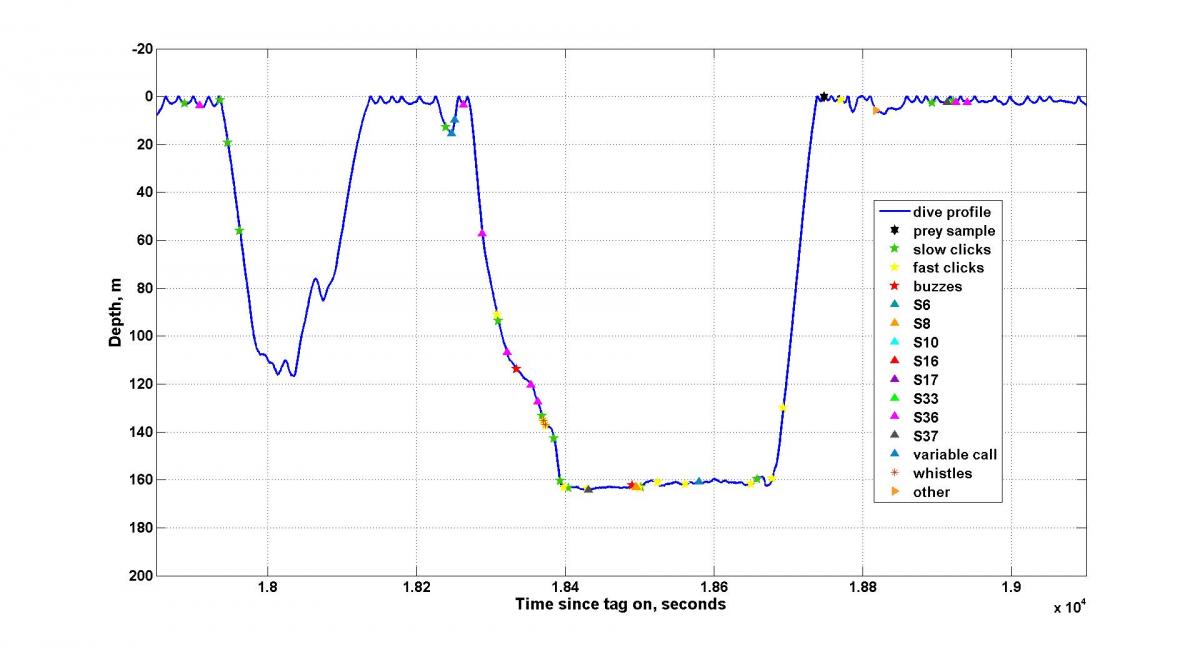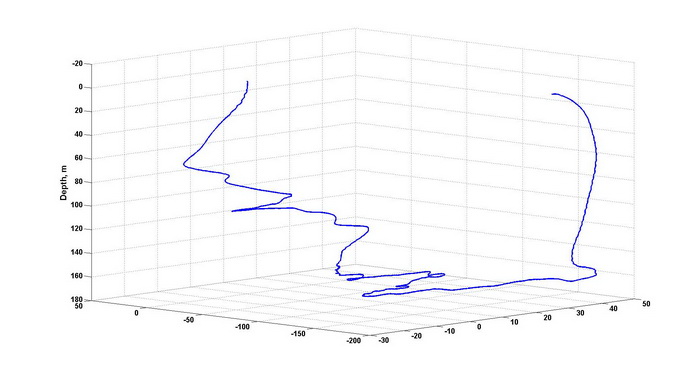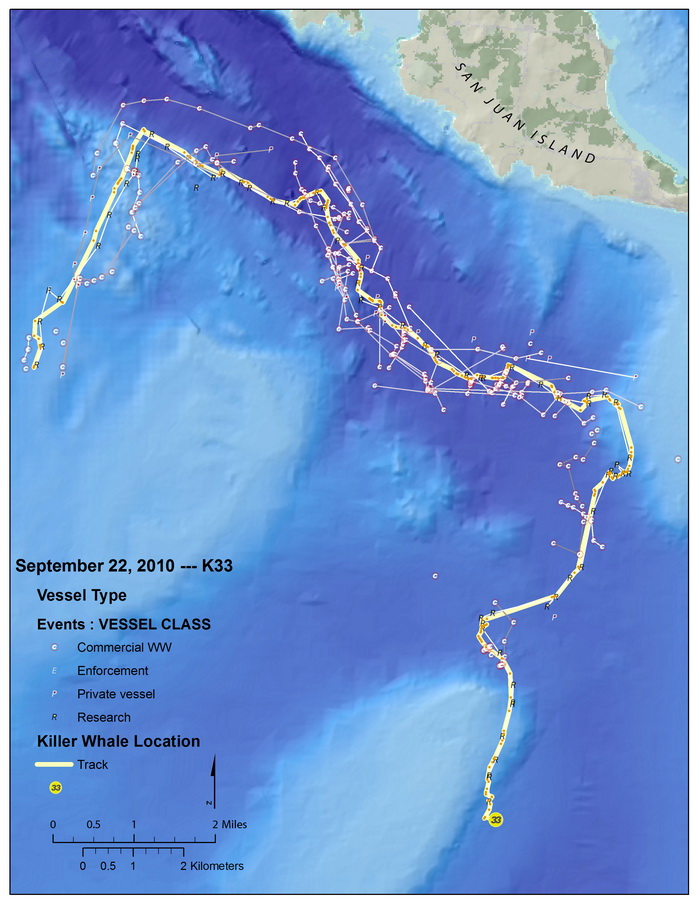Cascadia Research is collaborating with researchers from the NOAA Fisheries Northwest Fisheries Science Center (NWFSC) on a study using digital acoustic recording tags (DTAGs) to examine sound exposure, sound use and behavior.
Several risk factors were identified as part of the ESA listing process for Southern Resident killer whales (SRKWs), and were included in the recovery plan. These include prey quality and quantity, water pollution and environmental contaminants, vessel effects and sound exposure, and cumulative effects. A number of scientific studies conducted over the past several years have investigated foraging and dive behavior, behavioral responses to vessels and anthropogenic noise exposure in Southern Residents. All of these studies have provided important scientific information that has helped guide recovery efforts and other management decisions of endangered SR killer whales.
In particular, a need to accurately measure sound levels received by the whales was first identified at the SRKW research planning workshop in 2004. Specifically, it was noted that a recently developed instrument called the DTAG could provide this type of data and that there is no other approach to accurately characterize received sound levels. The DTAG was developed by Woods Hole Oceanographic Institution specifically to monitor the behavior of marine mammals, and their response to sound, continuously throughout the dive cycle (Johnson et al. 2009).

This study aims to address several of the risks factors noted previously while addressing limitations of previous studies using DTAGs and other complementary methods. This is important since further recovery efforts and management decisions of SRKWs will be based on the best available science and will likely affect many constituencies. The project research goals are as follows:
- Quantify noise levels in biological relevant frequency ranges that are received by individual SRKWs (as in Parks et al. 2011). Previous studies have quantified noise exposure in core summer habitat of SRKWs but these noise levels were approximated and not at the position of individuals.
- Quantify the relationship between vessels and received noise levels. Previous studies have correlated noise levels with nearby vessels in rather generalized ways (e.g., Holt et al. 2009). Further information is needed to determine how vessel noise emitted at the surface which varies in space and time affects free-ranging SRKWs diving in a three-dimensional environment. For example, SRKWs dive to considerable depths to hunt for prey. Empirical measurements of how vessel noise propagates with depth on a diving SRKW in core summer habitat are lacking.
- Investigate acoustic behavior during different activities and matched with fine scale details on movement, especially those indicative of foraging. These details will be validated with field observations including prey samples collected after successful prey capture. Acoustic signals are the predominate sensory cues of killer whales, given that sound travels more efficiently and much farther in water than in air. Killer whales, like all toothed whales, use active forms of sonar (called echolocation) to hunt for fish. Furthermore, they have group specific call dialects that are important for maintaining cohesion and coordinating movement over ranges that are limited by other sensory modalities (for example, vision). Thus, acoustic behavioral analyses will provide detailed information about how SRKWs use sound in specific biological and environmental contexts and how anthropogenic noise can potentially affect them.
- Quantify foraging efforts from such data and determine potential effects of vessels and associated noise levels. Previous studies have indicated that SRKWs decrease foraging activity, increase dive duration, swim speeds, and some surface active behaviors in the presence of vessels (Lusseau et al. 2009; Noren et al. 2009; Williams et al. 2009). However, acoustic data were not collected at the same time that these data were collected so it is unclear whether the physical presences of vessels, the noise associated with vessel activity or both contribute to the observed behavioral responses. In addition, killer whale behavior was limited to what scientific investigators could observe at the surface, and most of their behavior occurs well out of sight below the surface.

In September 2010, the NWFSC and Cascadia Research initiated a project to address the goals listed above using DTAGs. The DTAG has a variety of sensors including a hydrophone, to record received sound levels at the whale, and accelerometers to record their 3D movements under water. It is attached by suctions cups to the skin of the whale for a few hours before release at a preset time and floats for recovery. Its use has become widespread and is commonly used by the cetacean research community to address this type of question and has been shown to provide valuable data on dive behavior on numerous cetacean species, including killer whales, in other locations.
Our current project to some extent incorporates several different SRKW research projects that have been previously conducted separately. First, in the 1990s Robin Baird and Brad Hanson deployed suction-cup attached time-depth recorders (a less sophisticated version of the DTAG) on SRKW to assess diving behavior (click here for a paper from that study). Secondly we concurrently collect vessel position relative to the tagged whale in a manner similar to previous work (Giles and Cendak 2010), i.e., two integrated equipment packages that combined a global positioning system (GPS) with built-in data collectors (Trimble Geo HX and XM), a laser rangefinder to determine distance, and a compass to determine bearing, are used to record vessel data and further focal whale data (e.g. whale ID, group size, nearby conspecifics and surface behaviors; vessel ID, size, speed, and orientation). The data collected will allow for a comprehensive analysis of the complex interactions between vessels and whales at different spatio-temporal scales. Thirdly, Holt et al. (2009) conducted an acoustic study to assess vocal changes in response to increases in background noise levels and associated nearby vessels. Finally, we are incorporating our recently used methods of focal follows to assess prey selection and other behaviors by collecting fish scales and tissues from feeding events (click here for a paper from that study). Consequently, this project reduces research effort on the whales by coupling these previously separate efforts. By combining all these studies we get a much more meaningful data set.

DTAGs must be deployed by a long pole such that relatively close range approaches are necessary. We use a 7-m carbon fiber pole to deploy the tag such that we must approach to within about 6 m. These close approaches are allowed under our federally authorized research permits. A successful approach to the whales requires a very gradual process to match speed and course so as not cause the whales to alter their course or speed. Generally it takes about a half an hour to achieve this positioning – if we can’t achieve this position during this time frame we break off the encounter. We closely monitor the behavior of the whales prior to tag deployment and very precisely after deployment. Our field data, based on observations by several skilled observers, do not reflect any behavioral changes pre- and post-tagging.
During tag deployment we typically see little or no reaction, usually at most a flinch and fast dive, similar to how most species of whales and dolphins react to suction-cup tagging. Once the tag is deployed we move off approximately parallel to the whales, again matching speed and course and maintain a distance of approximately 150-200 m. During our 2010 deployments we maintained an average distance of 127 m (precisely measured using the GPS/rangefinder system noted above). We need to stay within a couple of hundred meters of the whale in order to accurately measure the distance of the whale from our boat with the range finder and ensure we can positively identify the individual throughout the tracking. We also need to periodically accurately photo-document the tag position/angle on the whale in order to be able to apply the proper offset to the accelerometer data. Consequently, we know exactly how far we are at all times as the distance to the whale is measured at least once during its surfacing between the longer dives.
We take several steps to maximize the sampling opportunities and thus reduce effort in the vicinity of the whales. Firstly, we have focused our effort over only a few week time period when the whales are in their core summer habitat and the weather is fairly good. It is also important that we maximize data collection per deployment in order to minimize the number of deployments while obtaining representative samples of whale and vessel data. Consequently, the tags are programmed to release at between 7 and 8 PM as we need to recover the tag and return to port before dark and down load the data and ready it for redeployment. It is generally late morning before the whales are located such that most days it is at least noon before we can be on scene. Even after the whales are found several factors slow or reduce the success rate of tagging which reduces the duration of each deployment. We try to work with small groups of whales because they surface slightly asynchronously which allows us critical lead time to slowly reposition the boat to deploy the tag. In addition we try to find slow traveling groups because consistent heading and relatively short dives make surfacing location more predictable. We avoid groups with calves under a year of age. We maneuver with the utmost care in close vicinity of the whales maintaining 360 degree monitoring. While we try to work in the absence of vessels, we are many times working in the presence of whale watch vessels because waiting the several hours until later in the day would significantly reduce the number of hours of data obtained for any deployment. We do work in front of whale watch vessels in a manner that attempts to minimize impacts to their guest experience. In particular we strive to work on the opposite side of the whale group so as not to obstruct the view of some the group’s members. However, because we are working in very close proximity, the whales occasionally come up on the opposite side of the boat.
During a 3 week effort in September 2010 we deployed tags on nine occasions for total of 29.7 hours of acoustic/dive data. Average duration of the tag attachments was 3.3 hours, with the longest tag staying on 7.5 hours. Five of the deployments were on L pod individuals, two on K pod individuals and two on J pod individuals. Three were deployed on sub-adult males, two on adult males, and four on adult females. Below are examples of preliminary data collected from 2010. Additional tags were deployed in June 2011 and September 2012. The field team for this work has included Brad Hanson, Candi Emmons and Marla Holt from the NWFSC, Debbie Giles from the University of California Davis, Juliana Houghton from the University of Washington, Jeff Hogan from Killer Whale Tales, and Robin Baird from Cascadia, among others.

The data collected to date show that the brief disturbance of the whales during the tagging process does not last, as the whales were observed to engage in similar behavior before and after tagging. Similarly, during the focal follow the whales engage in behaviors such as foraging.
The results of this study will provide pertinent data to address multiple risk factors of SRKWs and potential cumulative effects including vessel disturbance, noise exposure, and effects on foraging. This includes how these killer whales uses sounds in a three-dimensional environment, how anthropogenic exposures varies in space and time, and specific habitats and habitat features important for foraging in core summer habitat. Anthropogenic effects on foraging behavior is particularly concerning since these whales may be food limited and caloric restriction affects body condition, that in turns affects growth, survival and reproduction. Population growth is an integral recovery goal of any ESA listed species. Our study will provide key scientific information that will be particularly relevant for guiding and refining further management of SRKWs including addressing population recovery and other potential anthropogenic impacts such as tidal energy development.
References and further readings
Giles, D.A. and R. Cendak. 2011. An assessment of vessel effects on the cohesion and behavior state of Southern Resident killer whale groups in the Salish Sea. Report prepared under Contract No. AB133F-07-SE-3026, Northwest Fisheries Science Center. 56p.
Holt, M.M., D.P. Noren, V. Veirs, C.K. Emmons and S. Veirs. 2009. Speaking up: killer whales (Orcinus orca) increase their call amplitude in response to vessel noise. JASA Express Letters J. Acoust. Soc. Am. 125: EL 27-32.
Johnson, M., N. Aguilar and P.T. Madsen. 2009. Studying the behavior and sensory ecology of marine mammals using acoustic recording tags: a review. Marine Ecology Progress Series 395:55-73.
Lusseau, D., D.E. Bain, R. Williams and J.C. Smith. 2009. Vessel traffic disrupts the foraging behavior of southern resident killer whales Orcinus orca. Endangered Species Research 6:211-221.
Noren, D.P., A.H. Johnson, D. Rehder and A. Larson. 2009. Close approaches by vessels elicit surface active behaviors by Southern Resident killer whales. Endangered Species Research 8:179-192.
Parks, S.E., M. Johnson, D. Nowacek and P.L. Tyack. 2011. Individual right whales call louder in increased environmental noise. Biology Letters 7:33-35.
Williams, R., D.E. Bain, J.C. Smith and D. Lusseau. 2009. Effects of vessels on behaviour patterns of individual southern resident killer whales Orcinus orca. Endangered Species Research 6:199-209.
For more information on this research write to: brad.hanson (at) noaa.gov or rwbaird (at) cascadiaresearch.org